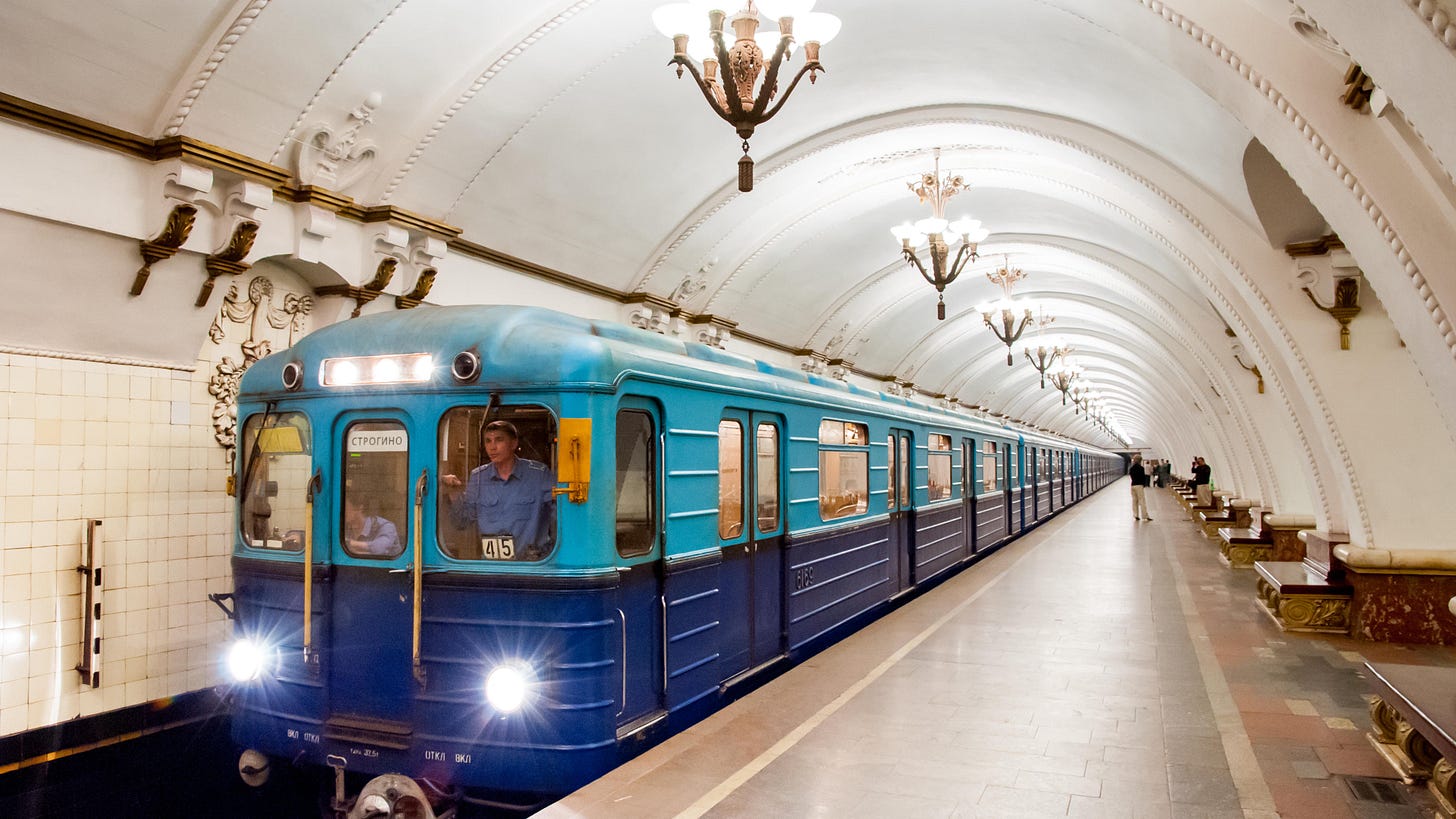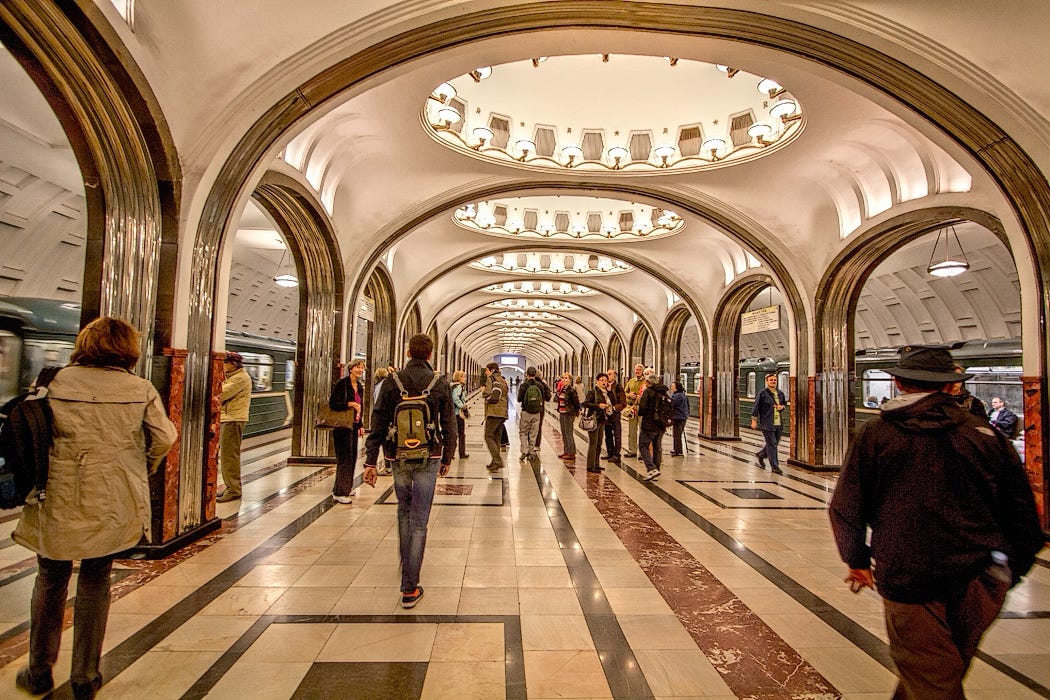The Moscow metro is commemorating its 90th anniversary where it proudly boasts of the past achievements where it has built over 100 stations from 2010 and aims to boost the number to around 302 stations by 2030. Its creation from 1935 was part of an attempt by the communist party to promote what they deemed was the superb merits of the socialist system.
And the Moscow metro does strike visitors as one of the most technically advanced, accessible and sophisticated in the World.
It's a masterpiece in not only engineering but in the simplicity of how passengers can use it. For you can easily orient yourself to it just by using the lines stretching out of the stations on the brown circle. In contrast to the complex, confusing and bewildering London underground, it is difficult to get lost. You don't have to pay money to change stations. You also don't have to wait long for a train.
The average waiting ranges from 85 seconds to only 5 minutes!
But the metro stations are not just a form of travel. They are often viewed as magnificent palaces with frescoes, murals and paintings. Some stations even resemble great cathedrals. At least 43 are considered cultural monuments. The metro stations were supposed to convince Russians that they could build anything and do anything. In 1935, when the first metro line was opened, the Moscow boss Lazar Kaganovich, boasted that “When our worker takes the metro, he should be cheerful and joyous. He should think of himself in a palace shining with the light of the advancing, all victorious Socialism.”
Orlando Figes writes - 'Drawing up their plans for the Stalin factory, {Avtozavod} Metro station during the late 1930's, the Vesnins likened the effect they aimed to achieve to the atmosphere inside a cathedral. The finished station {1943} with its high, almost gothic marble columns, its simple use of space and light, and its white marble bas reliefs depicting the 'achievements' of the Five-Year Plans, Magnitogorsk, the Stalin factory, the Palace of the Soviets, the Moscow -Volga canal, perfectly accomplished their idea.” {See page 151 of Orando Figes’ “The Whisperers,” 2008, New York & London: Penguin Books.}
All those wonderful things about the Moscow Metro will be loudly proclaimed during celebrations of this anniversary.
However, there are also a lot of dark shadows around the metro. One snag is that you can't live in those palaces. After the initial sense of wonder and elation most travellers in the 1930's had to return home to overcrowded, cramped, and squalid private spaces in which they lived….even though some had no home to return to.
The downside to all this is that the metro can succeed in falsely sending your mood soaring to new heights only to see it come crashing down again when you hit reality. You can look at the metro but can't get a job as a driver because you don't have a work permit or place of residence!
But it is perhaps the legends which have arisen around the Moscow metro which best serve to dent all the hype. It is easy to forget that many people who built the metro were Gulag prisoners who worked in appalling conditions. There were outbreaks of fire, and there were cave ins and all kinds of accidents. On the first line, over 100 workers died constructing it. In the construction of the Moscow-Volga Canal, thousands of workers may have died from exhaustion. Most people forget but at least a ghost story found in folklore books reminds you.
A ghost train is thought to go around the brown circle at around 12- 1 a.m. People who have witnessed this train state that the train staff are wearing old uniforms of the 1930's. The passengers are said to be the former prisoners who died building the metro.
The Moscow metro is full of such ghost stories. There are stories of passengers sitting next to you suddenly vanishing—or people becoming lost forever in the metro. For instance, in the Voikovskaya Metro Station people report the enactment of a person committing suicide by jumping in front of an incoming train . The person suddenly leaps off the platform before a coming train, but you don't hear any screams or see blood.
The two most famous stories of ghosts are the Black train driver and the trackman. The black train driver may be the former victim of a dreadful accident when a wagon caught fire and the driver got terrible injuries where he was badly burnt. The driver's action saved the lives of many passengers. He later died in hospital 3 days later. After an investigation into this incident the administration unjustly blamed the driver for the accident. They refused to grant compensation to the driver's wife and child. Since then, the black driver surfaces whenever a fire breaks out in the metro. The metro workers have caught sight of him driving away on a phantom train. His looms up to warn other train drivers of imminent disasters.
The trackman is a former worker who adored his work so much he never retired from it. He died at work aged 82! He is supposed to have worked at the metro for an estimated 40 years. He is still walking around the metro checking the conditions of equipment and rails. When he encounters workers he can scold them 'for not working hard enough or only for money.' He hates laziness. According to some reports, his ghost tends to appear on the eve of terrible disasters in the metro. For example, his ghost loomed up at the Aviamotornaya Metro Station on the 17th of February 1982 trying to warn people of an impending disaster. Many people died and were injured when an escalator collapsed. His ghost was also seen before a terrorist attack on the 8th of August 2000 as well at 5 o clock in the morning before a tremendous explosion on a train as it approached Lubyanka at 7.25 a.m. in 2010. So the trackman not only goes around the tunnels checking the rails, equipment and lightning but warns passengers of impending disasters.
The ghost of a monk is reputed to haunt the notorious Komsomol square of the three stations surrounding it: Yaroslavsky, Leningradsky and Kazansky. Those three stations are where many arrive from the provinces to seek work in Moscow. The homeless often end up at those three stations where they can stay the night in the waiting rooms or in some of the wagons. Every day, strangers arrive here from all over Russia seeking a better life in Moscow. For them, Moscow displays the dynamism of endless and boundless energy lacking in many of the stagnant hometowns they have hoped to escape. What they can't obtain in a poor village without work or prospects, they might attain in Moscow. The old saying - 'Anything is possible in Moscow' encourages such aspirations. Unfortunately, many of those people become homeless and never leave the 3 stations. So those 3 stations have become a kind of refuge for the homeless.
Those homeless might be forgiven for thinking they have been cursed by not just bad luck. And a legend would certainly serve to confirm their suspicion. For very few people are aware that this was once the location of a 14th-century monastery. The story goes that one terrible evening, stormy weather had erupted. A strong wind blew, and heavy rain pounded down. A starick {a wise spiritual advisor and man} came up to the gates of the monastery, asking for a place to stay the night. For some reason the monks refused. So the wanderer cursed the monastery with the words 'Let this monastery be swallowed up by the earth - the walls crack and fall into ruins.' And this is what happened. After the monastery collapsed nobody built anything on this site for 300 years. In the 18th century an Italian entrepreneur attempted to build a theatre here but it went on fire three times.
Some people have claimed that they have seen an old man with a stick who comes up to the Kazansky Station, falls upon his knees and crosses himself three times and then vanishes. Some people believe this is the old starick who originally cursed the monastery. But of course, it would seem odd if this man who had been denied a place to stay the night would choose to curse the fortune of homeless people also looking for a roof over their heads.
But if the metro and the three stations is haunted by ghosts it is also frequented with the unwanted presence of homeless people. Many can be seen sleeping on the seats of trains, in waiting rooms, and some have managed to live and made their own rooms in secret underground bunkers. In once incident a decade ago, the police found 100 illegal immigrants living in a bunker. Most were detained and deported.
The dark and dubious reputation of the three stations was given prominence in a novel by Martin Cruz Smith's novel “Three Stations.” It is important to stress that this novel is fiction and not a reliable guide to the actual reality of the Three Stations. This is because every year you have very frightened American tourists whose fears are vastly exaggerated when it comes to touring Moscow. For Smith, the homeless might as well be from another planet. Yes you see drunks at the three stations, but the number of them can be wildly overstated. Smith states, “Every doorway had a resident or two; they might be homeless but Three stations had their roost. A beggar with broad shoulders and withered legs propelled his cart past a Gypsy who absent-mindedly pulled out her baby and her breast. At Three Stations the crippled, outcast and usually hidden members of society gathered like the Court of Miracles only without the miracles.' {Pages 12 to 13 of “Three Stations” by Martin Cruz Smith, 2010, New York: Gallery Books}.
The last sentence appears to borrow a phrase used by Victor Hugo about a court of miracles where a gang of beggars has elected their own king of the beggars to simulate being blind or lame. During the daytime the beggars pretend to be blind, while at night they at once regain their sight! In a word, the Three stations is run by criminals and corruption where the police and drug dealers agree to work with each other. It is compared to a 'no-go area' you should avoid at all costs.
The novels such as “Gorky Park,” and “Three Stations” by Martin Cruz Smith, tend to see homelessness, poverty and collapse as something exotic, exciting and entertaining.
Of course, many of us enjoy detective novels and legends of ghosts. Legends also partly define the legacy of the metro. There are so many legends that any history of the metro can't ignore them. The commemoration of the 90th anniversary can also hardly avoid how best to respond to the conspicuous presence of the homeless in all the stations. Otherwise, we'll witness the return of the repressed again and again!




